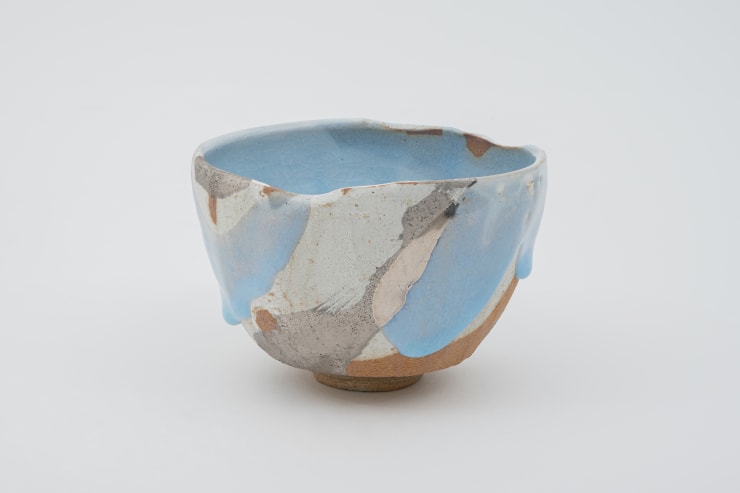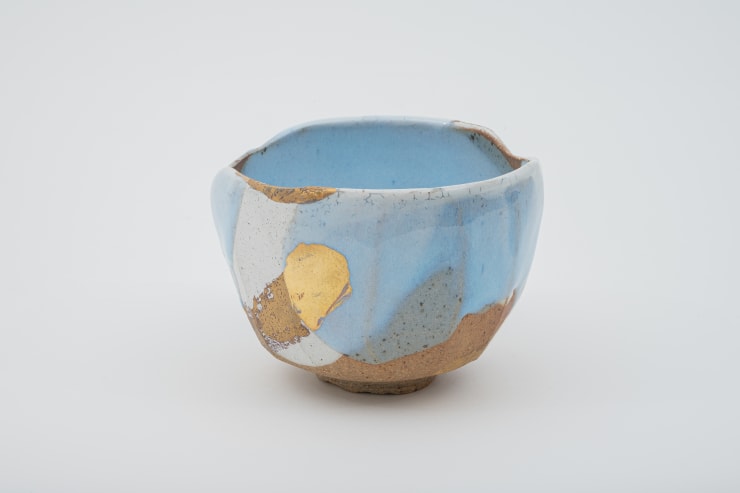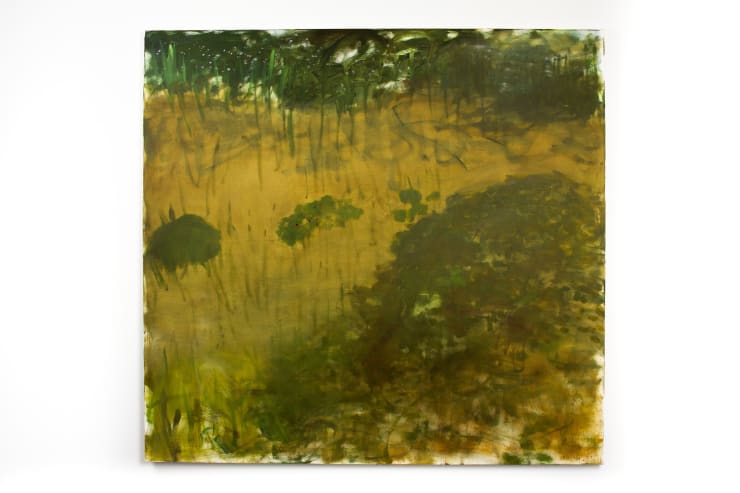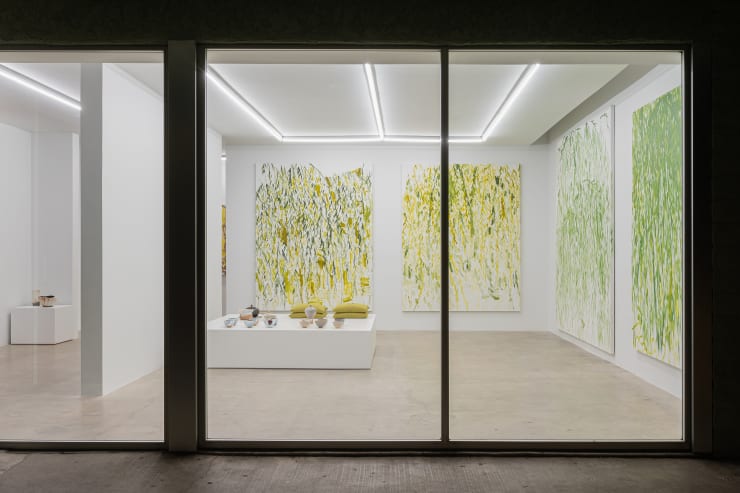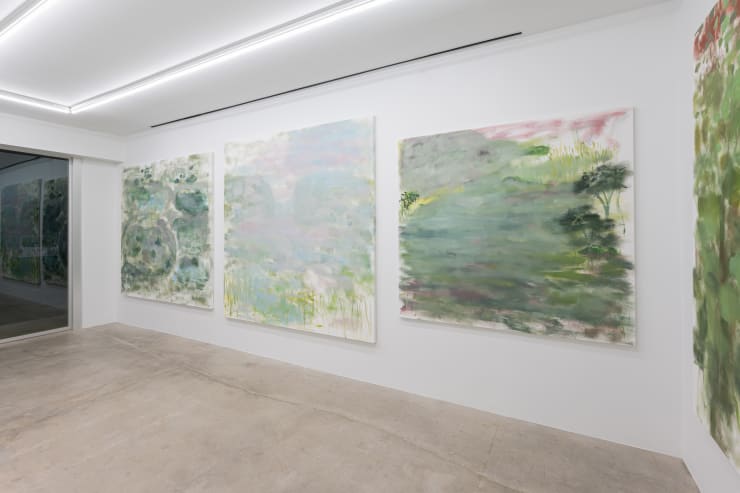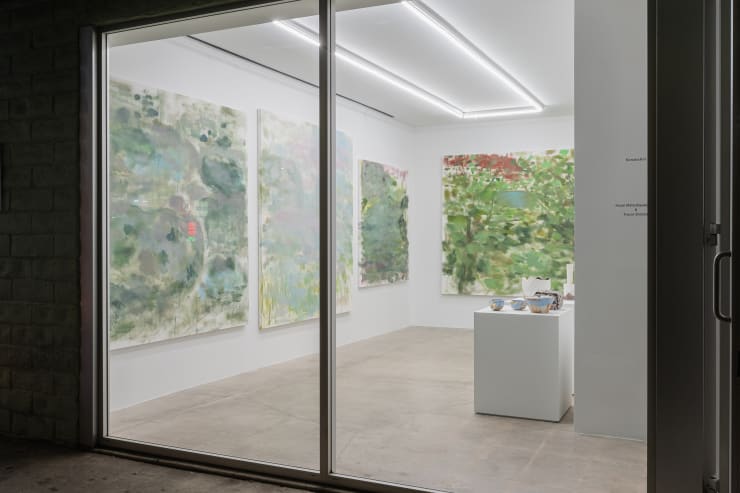Matsubayashi Hosai XVI & Trevor Shimizu
Press:
artillery, January 6, 2021
Nonaka-Hill is pleased to present a two-artist exhibition, Hosai Matsubayashi XVI and Trevor Shimizu. The exhibition brings tea ceremony ceramics produced by Matsubayashi at his Asahi-yaki (Asahi Pottery) kiln in Uji, Kyoto, Japan together with landscape and nature paintings by Shimizu, produced recently in Dobbs Ferry, New York. This symbiotic pairing derives from the notion that a Japanese tea ceremony might ideally be conducted in a tea house, ideally located in a garden or with a view onto a landscape.
Born Yusuke Matsubayashi (Hosai Matsubayashi XVI)
in 1980, the artist succeeded his father in 2016 to become the 16th generation to lead Asahi Pottery. In a name-changing ceremony, he took the honorary name of Hosai, assuming responsibility for the family and endurance of their kiln’s legacy. He has subsequently, consciously adapted his persona to embody “Hosai”, a merger which he says is becoming comfortable. At the Asahi studios, it has been customary for grandfather to teach the grandchildren about clay, perhaps assuring a two-generation transferal of techniques and sensibilities. Similarly, the family’s clay holdings are often stored across generations, drawn from the Uji region and fermented in their storehouse for up to 100 years. Mixed with waters from the Uji River, Asahi Pottery’s clays are characteristically smooth texture and even color. Generations of Matsubayashi artisans have worked within this lineage, and each has a chance to make their mark with personal expression. While his work is notable for its modern appearance, Matsubayashi XVI continues to evolve the Asahi kiln’s signature Kase glaze effect which imparts the appearance of deer or fawn fur onto cha-wan (teabowls). The six Kase cha-wan examples on view use pale yellow or red clays to show the spotted glaze with nuanced effect. Another distinctive glaze developed by Matsubayashi XVI called Geppaku (“moon white”) appears on water-containers and cha-wan. Geppaku glaze is light blue in color, opaque and gesturally applied to reveal a syrupy consistency, overlapping with other gestural marks in lacquer, gold or platinum. The artist also exhibits bowls and vases with matte finished slipware, revealing layers of color. In each of these works, the refined clays of Asahi Pottery are revealed under the special glazes, in keeping with the aesthetic ethos of kirei-sabi*, the appreciation of beautiful things.
American artist, Trevor Shimizu, often presents his own likeness through his work in video, photography, paintings, drawings and writings. Shimizu looks upon all the roles that life brings him- sports enthusiast, bass player, film extra, freelance photographer, Instagrammer, friend, boyfriend, husband, father and recently, landscape painter and embraces humor to investigate the images, ideas and experiences of masculinity that exist in Western culture, occasionally alluding to what his Asian roots mean, or don’t mean. While the landscape works on view may seem to be a surprising departure from the autobiographical works for which he has become known, the self-aware artist has surely thoroughly considered the way that these works fit into his overall story. Having recently moved to Dobbs Ferry on the Hudson River, this chapter might be called, “Artist has second child, moves out of the city, starts painting landscapes”.
Born in Santa Rosa, California in 1978, Trevor Shimizu's youth and college years were in idyllic Northern California. After moving to New York, a job at the art-video distributor Electronic Arts Intermix exposed Shimizu to a vanguard of artists working in video and shaped his artistic ambitions, but perhaps it's always been his destiny to become a romantic painter. Shimizu credits Vincent van Gogh for inspiring him to become a painter. Not only did his grandparents have a dog called van Gogh, but the two artists share the same birthdate and the same personality type, “Type Four (The Individualist)” according to the 1970s Enneagram Personality analysis. Another Impressionist, Pierre Bonnard, made still other deep impressions on Shimizu. MoMA’s 1998 Bonnard exhibition put Shimizu off from painting for a while, wherein he focused productively on other media, only to come back to painting later. It is Bonnard’s statement “I have all of my subjects at hand.” which appears to have effected Shimizu fundamentally as he has produced works of extraordinary (though often comic) domestic and psychological intimacy.
Shimizu's characteristically pure and crisp white canvases are, in fact, pre-gessoed and factory direct. His brushstrokes, which sit in stark contrast to the unmodified ground onto which they are painted, have been described as rakish, but here, they create a unity of form. Shimizu’s paintings, in general, always reveal the speed and clarity of his gesture, drawing a playful comparison to Japanese ink on paper calligraphy traditions such as Hitsuzendō (“way of Zen through brush”) and to Kirei-sabi, an appreciation of idealized beauty, Zen solitude and a sense of loneliness. In fact, these landscapes, water and willows are painted from the artist’s memories in grand-enough scale to feel experiential. While he does not appear in these works, nor does he impart any personal meaning with cleaver painting titles, the artist does make his presence known with his enormous signature, scrawled across the bottom of the paintings. Shimizu is at once self-questioning and self-amused, self-aggrandizing and through his art, self-immortalizing.
TEA CEREMONY
Hosai Mastubayashi XVI’s work, seen here in the United States, exists far outside of the context into which it was born, that of Chanoyu, the Tea Ceremony. This history is nuanced, and any attempt to essentialize and capture its essence is difficult and almost impossible, but here is a short description which leads to Asahi Pottery:
The ancient Silk Road meandered from The Mediterranean Sea, across Asia and into Japan through the port of Osaka, with the last leg of the route ending in Nara. Eighth Century products, production techniques, social customs and religions (Buddhism and Confucianism, significantly) arrived from outside of Japan making Nara a vibrant city where foreign influences were assimilated into the ranks of Japanese society. Nara became Japan’s first capital (710-794 AD) before it moved to nearby Kyoto (794 AD-1868 AD). The area is nowadays generally considered to be the cradle of Japanese civilization, in the middle of which lies the region of Uji which has produced Japan's premium green teas for centuries, and where Asahi Pottery has operated since 1600.
One imported Chinese custom, a tea connoisseurship game called Doucha, was transformed around the 1300s into the Japanese game called Tocha. Contestants would taste a number of different cups of tea to guess which region each cup of tea originated from. Prizes from these contests included silks, weapons, gold and jewelry. Such tea drinking activity became a forum for high-ranking members of society to gather, socialize and caffeinate, often becoming rowdy. One influential founder of Japan's disciplined tea ceremony, Murata Juko, is said to have frequented Tocha gatherings, seeking caffeine to stay awake for his studies.
Studying Zen under the renowned master, Ikkyu (1394 AD – 1481 AD), Murata Juko (b 1421 AD) was encouraged to realize the Buddhist path that exists within Chanoyu (the Tea Ceremony). Juko was the first to assign the words hie and kare (chill and withered) as descriptors of the tea ceremony in his famous letter Kokoro No Fumi (‘Text of the Heart’ or ‘Letter on Heart’s Mastery’). Alluding to the aesthetic orientation of Zen Buddhism and encouraging the appreciation for Japanese native wares alongside their Chinese and Korean counterparts which were commonly collected and used, these ideas of hie and kare slowly transformed into concepts of wabi, which have made their way into the Western vernacular, as appreciation of a beauty that is imperfect, incomplete, and impermanent.
Two generations after Juko, Kobori Enshu (1579 AD-1647 AD), a famous tea practitioner, situated aesthetic appreciation of the tea object under kirei-sabi*, which, inspired by Juko’s famous letter, focuses on a sense of elegance and purity in the selection of utensils and objects used in the tea ceremony. In addition to a focus on the tea room, garden, and scroll, Enshu designated seven kilns as the preferred producers of such Japanese produced ‘meibutsu’ (famed utensils). Asahi kiln, run by the Matsubayashi family, was one of these seven Enshu chosen kilns. From this legacy, Hosai Matsubayashi XVI’s family-owned pottery studio was established and continues to this day.
THE SHOW
For early influential tea practitioners, Tea Ceremony offered an alternate space, a place of safety, relaxation, and comradery, one that became more aligned with the way of the inner life than the ostentatious display of wealth. In cultivating this inner life and appreciation, Enshu cared deeply about what one looked upon when looking out from within.
Alluding to such a contemplative natural atmosphere (and counterbalancing the gallery’s view onto a Los Angeles mini-mall parking lot), Shimizu’s large-scale paintings have been sequentially installed to fill the gallery’s perimeter walls, attempting to assemble an ad-hoc panorama alluding to Monet’s Water Lily paintings, which themselves bear relationship to Japan and are exquisitely temporal.
Special thanks to Amy Poncher for her collaboration on this text.
 Hosai Matsubayashi XVIKase Tea bowl (deer back) / 茶盌 鹿背 , 2020Ceramic, ash glaze. 陶器/灰釉2 7/8 x 5 1/8 in
Hosai Matsubayashi XVIKase Tea bowl (deer back) / 茶盌 鹿背 , 2020Ceramic, ash glaze. 陶器/灰釉2 7/8 x 5 1/8 in
7.3 x 12.8 cm Hosai Matsubayashi XVIKase Tea bowl (deer back herame) 茶盌 (鹿背箆目), 2020Ceramic 陶器/灰釉3 1/8 x 4 7/8 in
Hosai Matsubayashi XVIKase Tea bowl (deer back herame) 茶盌 (鹿背箆目), 2020Ceramic 陶器/灰釉3 1/8 x 4 7/8 in
7.9 x 12.4 cm Hosai Matsubayashi XVIBeni Tea bowl (red deer back pattern herame) 茶盌 (紅鹿背箆目) , 2020Ceramic 陶器/灰釉3 3/8 x 4 7/8 x 4 3/4 in
Hosai Matsubayashi XVIBeni Tea bowl (red deer back pattern herame) 茶盌 (紅鹿背箆目) , 2020Ceramic 陶器/灰釉3 3/8 x 4 7/8 x 4 3/4 in
8.5 x 12.4 x 11.9 cm Hosai Matsubayashi XVIBeni Kase Tea bowl (red deer back herame) / 茶盌 鹿背箆目, 2020Ceramic, ash glaze. 陶器/灰釉3 1/8 x 5 5/8 in
Hosai Matsubayashi XVIBeni Kase Tea bowl (red deer back herame) / 茶盌 鹿背箆目, 2020Ceramic, ash glaze. 陶器/灰釉3 1/8 x 5 5/8 in
8 x 14.2 cm Hosai Matsubayashi XVIKase Tea bowl (red deer back, brush stroke) / 茶盌 紅鹿背刷毛目, 2020Ceramic. 陶器/灰釉3 1/4 x 5 1/8 in
Hosai Matsubayashi XVIKase Tea bowl (red deer back, brush stroke) / 茶盌 紅鹿背刷毛目, 2020Ceramic. 陶器/灰釉3 1/4 x 5 1/8 in
8.3 x 12.9 cm Hosai Matsubayashi XVIKase Chawan 鹿背 茶碗, 2019Ceramic, glaze2-3/4 x 5-1/2 x 5-1/2 inches
Hosai Matsubayashi XVIKase Chawan 鹿背 茶碗, 2019Ceramic, glaze2-3/4 x 5-1/2 x 5-1/2 inches
7 x 14 x 14 cm Hosai Matsubayashi XVIMizusashi (water keeper) Geppaku glaze / 水指 月白釉流し/, 2020Ceramic, ash glaze. 陶器/灰釉5 1/8 x 8 5/8 in
Hosai Matsubayashi XVIMizusashi (water keeper) Geppaku glaze / 水指 月白釉流し/, 2020Ceramic, ash glaze. 陶器/灰釉5 1/8 x 8 5/8 in
13.1 x 22 cm Hosai Matsubayashi XVIGeppaku glaze Chawan / 月白釉流シ 茶碗, 2020Ceramic, ash glaze. 陶器/灰釉3 1/8 x 4 7/8 x 4 1/2 in
Hosai Matsubayashi XVIGeppaku glaze Chawan / 月白釉流シ 茶碗, 2020Ceramic, ash glaze. 陶器/灰釉3 1/8 x 4 7/8 x 4 1/2 in
8 x 12.5 x 11.4 cm Hosai Matsubayashi XVIGeppaku glaze Chawan / 月白釉流シ 茶碗, 2020Ceramic, ash glaze. 陶器/灰釉3 1/4 x 5 x 4 3/8 in
Hosai Matsubayashi XVIGeppaku glaze Chawan / 月白釉流シ 茶碗, 2020Ceramic, ash glaze. 陶器/灰釉3 1/4 x 5 x 4 3/8 in
8.2 x 12.7 x 11.2 cm Hosai Matsubayashi XVIGeppaku glaze with platinum Chawan / 茶盌 月白釉流シプラチナ彩, 2020Ceramic, ash glaze, platinum. 陶器/灰釉、プラチナ焼付3 3/8 x 5 x 4 5/8 in
Hosai Matsubayashi XVIGeppaku glaze with platinum Chawan / 茶盌 月白釉流シプラチナ彩, 2020Ceramic, ash glaze, platinum. 陶器/灰釉、プラチナ焼付3 3/8 x 5 x 4 5/8 in
8.6 x 12.7 x 11.8 cm Hosai Matsubayashi XVIGeppaku glaze with gold Chawan / 月白釉流シ金彩, 2020Ceramic, ash glaze, gold. 陶器/灰釉、金焼付3 1/2 x 4 3/4 x 4 3/4 in
Hosai Matsubayashi XVIGeppaku glaze with gold Chawan / 月白釉流シ金彩, 2020Ceramic, ash glaze, gold. 陶器/灰釉、金焼付3 1/2 x 4 3/4 x 4 3/4 in
8.9 x 12.2 x 11.9 cm Hosai Matsubayashi XVIGeppaku glaze with gold Chawan / 月白釉流シ金彩, 2020Ceramic, ash glaze, gold. 陶器/灰釉、金焼付3 3/8 x 4 5/8 x 4 1/2 in
Hosai Matsubayashi XVIGeppaku glaze with gold Chawan / 月白釉流シ金彩, 2020Ceramic, ash glaze, gold. 陶器/灰釉、金焼付3 3/8 x 4 5/8 x 4 1/2 in
8.5 x 11.8 x 11.5 cm Hosai Matsubayashi XVIGeppaku glaze with gold Chawan / 月白釉流シ金彩, 2020Ceramic, ash glaze, gold. 陶器/灰釉、金焼付2 7/8 x 5 1/4 x 4 7/8 in
Hosai Matsubayashi XVIGeppaku glaze with gold Chawan / 月白釉流シ金彩, 2020Ceramic, ash glaze, gold. 陶器/灰釉、金焼付2 7/8 x 5 1/4 x 4 7/8 in
7.2 x 13.3 x 12.4 cm Hosai Matsubayashi XVIGeppaku glaze with lacquer / 茶盌 陶漆合作 塗 西村圭功, 2020Ceramic, ash glaze, lacquer. 陶器/灰釉、漆3 3/8 x 4 3/4 x 4 3/8 in
Hosai Matsubayashi XVIGeppaku glaze with lacquer / 茶盌 陶漆合作 塗 西村圭功, 2020Ceramic, ash glaze, lacquer. 陶器/灰釉、漆3 3/8 x 4 3/4 x 4 3/8 in
8.6 x 11.9 x 11.2 cm Hosai Matsubayashi XVIGeppaku glaze with lacquer / 茶盌 陶漆合作 塗 西村圭功, 2020Ceramic, ash glaze, lacquer. 陶器/灰釉、漆3 5/8 x 4 7/8 x 4 3/4 in
Hosai Matsubayashi XVIGeppaku glaze with lacquer / 茶盌 陶漆合作 塗 西村圭功, 2020Ceramic, ash glaze, lacquer. 陶器/灰釉、漆3 5/8 x 4 7/8 x 4 3/4 in
9.3 x 12.4 x 11.9 cm Hosai Matsubayashi XVIGeppaku glaze Chawan 月白釉流シ 茶碗, 2019Ceramic, slip, glaze3-3/8 x 5-1/4 x 4-1/2 inches
Hosai Matsubayashi XVIGeppaku glaze Chawan 月白釉流シ 茶碗, 2019Ceramic, slip, glaze3-3/8 x 5-1/4 x 4-1/2 inches
8.5 x 13 x 11.5 cm Hosai Matsubayashi XVIBeni Kase Vase / 花入 紅鹿背, 2020Ceramic. 陶器/灰釉9 1/8 x 5 5/8 in
Hosai Matsubayashi XVIBeni Kase Vase / 花入 紅鹿背, 2020Ceramic. 陶器/灰釉9 1/8 x 5 5/8 in
23 x 14.3 cm Hosai Matsubayashi XVIKohiki and Black glaze Vase / 花器 粉引黒釉/V, 2020Ceramic, graze / 陶器/灰釉6 3/8 x 13 5/8 x 9 5/8 in
Hosai Matsubayashi XVIKohiki and Black glaze Vase / 花器 粉引黒釉/V, 2020Ceramic, graze / 陶器/灰釉6 3/8 x 13 5/8 x 9 5/8 in
16.3 x 34.5 x 24.5 cm Hosai Matsubayashi XVIKohiki and Black glaze Vase / 花器 粉引黒釉, 2020Ceramic. 陶器/灰釉8 1/4 x 13 7/8 x 8 1/4 in
Hosai Matsubayashi XVIKohiki and Black glaze Vase / 花器 粉引黒釉, 2020Ceramic. 陶器/灰釉8 1/4 x 13 7/8 x 8 1/4 in
21 x 35.2 x 21 cm Hosai Matsubayashi XVIKohiki Vase / 花入 粉引砧形/ , 2020Ceramic. 陶器/灰釉12 3/4 x 3 7/8 in
Hosai Matsubayashi XVIKohiki Vase / 花入 粉引砧形/ , 2020Ceramic. 陶器/灰釉12 3/4 x 3 7/8 in
32.3 x 9.9 cm Hosai Matsubayashi XVIKohiki Vase 粉引 花器, 2019Ceramic, slip9-1/2 x 4-1/2 x 4-1/2 inches
Hosai Matsubayashi XVIKohiki Vase 粉引 花器, 2019Ceramic, slip9-1/2 x 4-1/2 x 4-1/2 inches
24 x 11.5 x 11.5 cm Trevor ShimizuWeeping Willow (7), 2019Oil on canvas.114 x 114 in
Trevor ShimizuWeeping Willow (7), 2019Oil on canvas.114 x 114 in
289.6 x 289.6 cm Trevor ShimizuWeeping Willow (4), 2019Oil on canvas.98 x 78 in
Trevor ShimizuWeeping Willow (4), 2019Oil on canvas.98 x 78 in
248.9 x 198.1 cm Trevor ShimizuWeeping Willow (2), 2019Oil on canvas.96 x 77 in
Trevor ShimizuWeeping Willow (2), 2019Oil on canvas.96 x 77 in
243.8 x 195.6 cm Trevor ShimizuWeeping Willow (1), 2019Oil on canvas.96 x 76 in
Trevor ShimizuWeeping Willow (1), 2019Oil on canvas.96 x 76 in
243.8 x 193 cm Trevor ShimizuForsythia and Chipmunk, 2019Oil on canvas.53 × 49 1/2 in
Trevor ShimizuForsythia and Chipmunk, 2019Oil on canvas.53 × 49 1/2 in
134.62 × 125.73 cm Trevor ShimizuWater Through Trees, 2020Oil on canvas.82 x 90 in
Trevor ShimizuWater Through Trees, 2020Oil on canvas.82 x 90 in
208.3 x 228.6 cm Trevor ShimizuWater Surrounded by Cliffs and Trees, 2020Oil on canvas.approx. 66 x 70 in
Trevor ShimizuWater Surrounded by Cliffs and Trees, 2020Oil on canvas.approx. 66 x 70 in
167.64 x 177.80 cm Trevor ShimizuTide Pools (2), 2020Oil on canvas.82 x 88 in
Trevor ShimizuTide Pools (2), 2020Oil on canvas.82 x 88 in
208.3 x 223.5 cm Trevor ShimizuSunset Cove, 2020Oil on canvas.86 x 88 in
Trevor ShimizuSunset Cove, 2020Oil on canvas.86 x 88 in
218.44 x 223.52 cm Trevor ShimizuRedwood Trees and Banana Slug, 2019Oil on canvas.100 x 78 in
Trevor ShimizuRedwood Trees and Banana Slug, 2019Oil on canvas.100 x 78 in
254 x 198.1 cm Trevor ShimizuSpooky Pines, 2020Oil on canvas.approx. 40 x 50 in
Trevor ShimizuSpooky Pines, 2020Oil on canvas.approx. 40 x 50 in
101.6 x 127 cm Trevor ShimizuOcean and Trees, 2019Oil on canvas.23 x 30 in
Trevor ShimizuOcean and Trees, 2019Oil on canvas.23 x 30 in
58.4 x 76.2 cm Trevor ShimizuLavender, 2019Oil on canvas.68 x 64 in
Trevor ShimizuLavender, 2019Oil on canvas.68 x 64 in
172.7 x 162.6 cm Trevor ShimizuMoss (detail) (3), 2019Oil on canvas.18 x 27 in
Trevor ShimizuMoss (detail) (3), 2019Oil on canvas.18 x 27 in
45.7 x 68.6 cm Trevor ShimizuMoss (2), 2019Oil on canvas.21 x 25 in
Trevor ShimizuMoss (2), 2019Oil on canvas.21 x 25 in
53.3 x 63.5 cm Trevor ShimizuMoss (1), 2019Oil on canvas.19 x 25 in
Trevor ShimizuMoss (1), 2019Oil on canvas.19 x 25 in
48.3 x 63.5 cm Trevor ShimizuMarsh Small (2), 2019Oil on canvas.22 x 30 in
Trevor ShimizuMarsh Small (2), 2019Oil on canvas.22 x 30 in
55.9 x 76.2 cm Trevor ShimizuMarsh Small (1), 2019Oil on canvas.22 x 30 in
Trevor ShimizuMarsh Small (1), 2019Oil on canvas.22 x 30 in
55.9 x 76.2 cm
Related artists
Artist Exhibited:
Ulala Imai
Kazuo Kadonaga
Kentaro Kawabata
Zenzaburo Kojima
Kisho Kurokawa
Tadaaki Kuwayama
Toshio Matsumoto
Keita Matsunaga
Yutaka Matsuzawa
Kimiyo Mishima
Kunié Sugiura
Takuro Tamayama
Tiger Tateishi
Sofu Teshigahara
Shomei Tomatsu
Wataru Tominaga
Hosai Matsubayashi XVI
Kansuke Yamamoto
Masaomi Yasunaga
Exhibitions:
-2025-
-2024-
KYOKO IDETSU: What can an ideology do for me?
KENTARO KAWABATA / BRUCE NAUMAN
SAORI (MADOKORO) AKUTAGAWA: CENTENARIA
Keita Matsunaga : Accumulation Flow
-2023-
NONAKA-HILL ♥ TATAMI ANTIQUES: A holiday sale of unique objects from Japan
TAKASHI HOMMA : REVOLUTION No.9 / Camera Obscura Studies
TATSUMI HIJIKATA THE LAST BUTOH: Photographs by Yasuo Kuroda
Kiyomizu Rokubey VIII: CERAMIC SIGHT
Masaomi Yasunaga: 石拾いからの発見 / discoveries from picking up stones
SHUZO AZUCHI GULLIVER ‘Synogenesis’
Koichi Enomoto: Against the day
Tatsuo Ikeda / Michael E. Smith
Hiroshi Sugito: the garden with Zenzaburo Kojima
Zenzaburo Kojima: This very green
Tomohisa Obana: To see the rainbow at night, I must make it myself
Daisuke Fukunaga: Beautiful Work
- 2021 -
Natsuyasumi: In the Beginning Was Love
Takashi Homma: mushrooms from the forest
– 2020 –
Hosai Matsubayashi XVI & Trevor Shimizu
Sterling Ruby and Masaomi Yasunaga
– 2019 –
A show about an architectural monograph
Yutaka Matsuzawa
Yutaka Matsuzawa through the lens of Mitsutoshi Hanaga
Takuro Tamayama & Tiger Tateishi
Kunié Sugiura
Masaomi Yasunaga
Miho Dohi
Wataru Tominaga
Naotaka Hiro
Parergon: Japanese Art of the 1980s and 1990s
Tadaaki Kuwayama
– 2018 –
Toshio Matsumoto
Kentaro Kawabata
Kansuke Yamamoto
Kazuo Kadonaga: Wood / Paper / Bamboo / Glass
Press:
-2025-
Artillery Magazine, Sawako Goda
-2024-
Artsy, Nonaka-Hill
Richesse, Nonaka-Hill Kyoto
Bijutsutecho, Nonaka-Hill Kyoto
The Art Newspaper, Nonaka-Hill Kyoto
Meer, Kyoko Idetsu
Bijyutsutecho, Masaomi Yasunaga
Switch, Masaomi Yasunaga
ARTnews JAPAN, Masaomi Yasunaga
Richesse, Masaomi Yasunaga
Art Basel, Daisuke Fukunaga, Imai Ulala
Art Basel, Kazuo Kadonaga, Sofu Teshigahara
-2023-
ADF webmagazine, Yasuo Kuroda, Tatsumi Hijikata
e-flux, Sanya Kantarofsky, Yasuo Kuroda
Los Angeles Times, Kenzi Shiokava
Artillery, Masaomi Yasunaga
Contemporary Art Daily Shuzo Azuchi Gulliver
- 2022 -
Contemporary Art Daily, Tomohisa Obana
ARTE FUSE, Daisuke Fukunaga
Contemporary Art Daily, Daisuke Fukunaga
Contemporary Art Review Los Angeles (Carla), Daisuke Fukunaga
What's on Los Angeles, Daisuke Fukunaga
Hyperallergic, Daisuke Fukunaga
Artillery, Kentaro Kawabata
Larchmont Buzz, entaro Kawabata
- 2021 -
Art Viewer, Natsuyasumi: In the Beginning Was Love
Hyperallergic, Natsuyasumi: In the Beginning Was Love
Art Viewer, Takashi Homma
Hyperallergic, Busy Work at Home
Art Viewer, Busy Work at Home
Hyperallergic, Ulala Imai
Contemporary Art Review Los Angeles (Carla), Ulala Imai
Contemporary Art Daily, Ulala Imai
artillery, Ulala Imai
Special Ops, Ulala Imai
Art Viewer, Ulala Imai
artillery, Matsubayashi & Trevor Shimizu
– 2020 –
Ceramic Now, Sterling Ryby and Masaomi Yasunaga
Hypebeast, Sterling Ryby and Masaomi Yasunaga
Art Viewer, Sterling Ruby and Masaomi Yasunaga
Air Mail, Sterling Ruby and Masaomi Yasunaga
Los Angeles Times, Kaz Oshiro
ArtnowLA, Kaz Oshiro
What's on Los Angeles, Kaz Oshiro
KCRW, Kaz Oshiro
Tique, Kaz Oshiro
Contemporary Art Daily, Kaz Oshiro
Art Viewer, Kaz Oshiro
Contemporary Art Daily, Sofu Teshigahara
Art Viewer, Sofu Teshigahara
KCRW, Sofu Tsshigahara
Hyperallergic, Nonaka-Hill
Los Angeles Times, Keita Matsunaga
– 2019 –
Los Angeles Times, Tatsumi Hijikata
Art Viewer, Tatsumi Hijikata, Eikoh Hosoe
Contemporary Art Review Los Angeles, Tatsumi Hijikata, Eikoh Hosoe
ArtAsiaPacific, Yutaka Matsuzawa
Los Angeles Times, Tatsumi Hijikata
AUTRE, Tatsumi Hijikata, Eikoh Hosoe
Los Angeles Times, Nonaka-Hill
ARTFORUM, Takuro Tamayama, Tiger Tateishi
Art Viewer, Takuro Tamayama, Tiger Tateishi
KCRW, Nonaka-Hill
LA WEEKLY, Nonaka-Hill
AUTRE, Takuro Tamayama, Tiger Tateishi
ArtsuZe, Takuro Tamayama, Tiger Tateishi
ARTFORUM, Review: Tadaaki Kuwayama, Rakuko Naito
Art Viewer, Masaomi Yasunaga, Kunié Sugiura
Los Angeles Times, Masaomi Yasunaga
KQED, Tadaaki Kuwayama, Rakuko Naito
Contemporary Art Daily, Naotaka Hiro, Wataru Tominaga, Miho Dohi
Los Angeles Times, Miho Dohi
Los Angeles Review of Books, Miho Dohi
Bijutsu Techo, Naotaka Hiro, Wataru Tominaga, Miho Dohi
Art Viewer, Miho Dohi
Art & Object, Parergon
COOL HUNTING, Felix Art Fair
Art Viewer, Tadaaki Kuwayama
artnet news, Nonaka-Hill
Contemporary Art Review Los Angeles (Carla), Tadaaki Kuwayama
– 2018 –
Art Viewer, Kentaro Kawabata
Contemporary Art Daily, Kazuo kadonaga
Los Angeles Times, Kazuo Kadonaga
ARTFORUM, Kazuo Kadonaga
Contemporary Art Daily, Shomei Tomatsu
KCRW, Kimiyo Mishima, Shomei Tomatsu
This website uses cookies
This site uses cookies to help make it more useful to you. Find out more about cookies.










